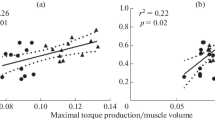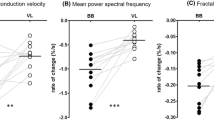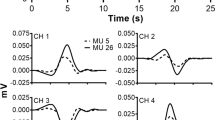Summary
The main fibre types ofM. vastus lateralis of 10 trained or untrained male individuals (25–35 years) were quantitatively determined by morphological techniques; the fibre types being defined according to the M-band appearance. The volume density of mitochondria (Vmit) was higher in endurance-trained muscles.Vmit was higher in Type 1 than in Type 2 fibres, there being no difference between subtypes of Type 2 fibres. The volume density of lipid droplets (Vli) showed a wide range of values both with respect to degree of training and between fibre types. Z-band width was not influenced by endurance training, but was considerably larger in Type 1 than in Type 2 fibres. Discriminant analysis showed that 46% of the fibres, preclassified according to the M-band appearance, would have been correctly allocated on basis of theVmit. The corresponding value for lipid droplets was 42% and for the Z-band width, 62%.
It is concluded thatVmit is not a satisfactory criterion for discriminating between fibre types, especially between Type 2A and Type 2B in trained subjects. The study also shows that endurance training reduces the relative importance of individual-dependent factors in comparison with muscle fibre properties when concerningVmit.
Similar content being viewed by others
References
Costill DL, Gollnick PD, Jansson ED, Saltin B, Stein EM (1973) Glycogen depletion pattern in human muscle fibres during distance running. Acta Physiol Scand 89: 374–383
Essén B (1978) Glycogen depletion of different fibre types in human skeletal muscle during intermittent and continuous exercise. Acta Physiol Scand 103: 446–455
Essén-Gustavsson B, Henriksson J (1983) Enzyme profiles in type I, IIA, and IIB fibre populations of human skeletal muscle. In: Knuttgen H, Vogel JA, Poortmans J (eds) Biochemistry of exercise. Human Kinetics Publishers, Champaign, pp 447–452
Gollnick PD, Piehl K, Saltin B (1974) Selective glycogen depletion pattern in human muscle fibres after exercise of varying intensity and at varying pedalling rates. J Physiol 241: 45–57
Holloszy JO, Booth FW (1976) Biochemical adaptations to endurance exercise in muscle. Annu Rev Physiol 38: 273–291
Hoppeler H, Luethi P, Claassen H, Weibel ER, Howald H (1973) The ultrastructure of the normal human skeletal muscle. A morphometric analysis on untrained men, women and well-trained orienteers. Pfluegers Arch 344: 217–232
Kiessling KH, Pilström L, Bylund AC, Saltin B, Piehl K (1974) Enzyme activities and morphometry in skeletal muscle of middle-aged men after training. Scand J Clin Lab Invest 33: 63–69
Morgan TE, Cobb LA, Short FA, Ross R, Gunn DR (1971) Effects of long-term exercise on human muscle mitochondria. In: Pernow B, Saltin B (eds) Muscle metabolism during exercise. Plenum Press, New York London, pp 87–95
Prince FP, Hikida RS, Hagerman FC, Staron RS, Allen WH (1981) A morphometric analysis of human muscle fibers with relation to fiber types and adaptations to exercise. J Neurol Sci 49: 165–179
Reichmann H, Pette D (1982) A comparative microphotometric study of succinate dehydrogenase activity levels in Type I, IIA, and IIB fibres of mammalian and human muscles. Histochemistry 74: 27–41
Salmons S, Henriksson J (1981) The adaptive response of skeletal muscle to increased use. Muscle Nerve 4: 94–105
Sjöström M, Ängquist KA, Bylund AC, Fridén J, Gustavsson L, Scherstén T (1982a) Morphometric analyses of human muscle fiber types. Muscle Nerve 5: 538–553
Sjöström M, Fridén J, Ekblom B (1982b) Fine structural details of human muscle fibres after fibre type specific glycogen depletion. Histochemistry 76: 425–438
Sjöström M, Kidman S, Henriksson-Larsén K, Ängquist KA (1982c) Z- and M-band appearance in different histochemically defined types of human skeletal muscle fibers. J Histochem Cytochem 30: 1–11
Sjöström M, Thornell LE, Hellström S (1973) An efficient standardized method of staining ultrathin sections for electron microscopy. J Ultrastruct Res 42: 180–185
Author information
Authors and Affiliations
Rights and permissions
About this article
Cite this article
Fridén, J., Sjöström, M. & Ekblom, B. Muscle fibre type characteristics in endurance trained and untrained individuals. Europ. J. Appl. Physiol. 52, 266–271 (1984). https://doi.org/10.1007/BF01015207
Accepted:
Issue Date:
DOI: https://doi.org/10.1007/BF01015207




